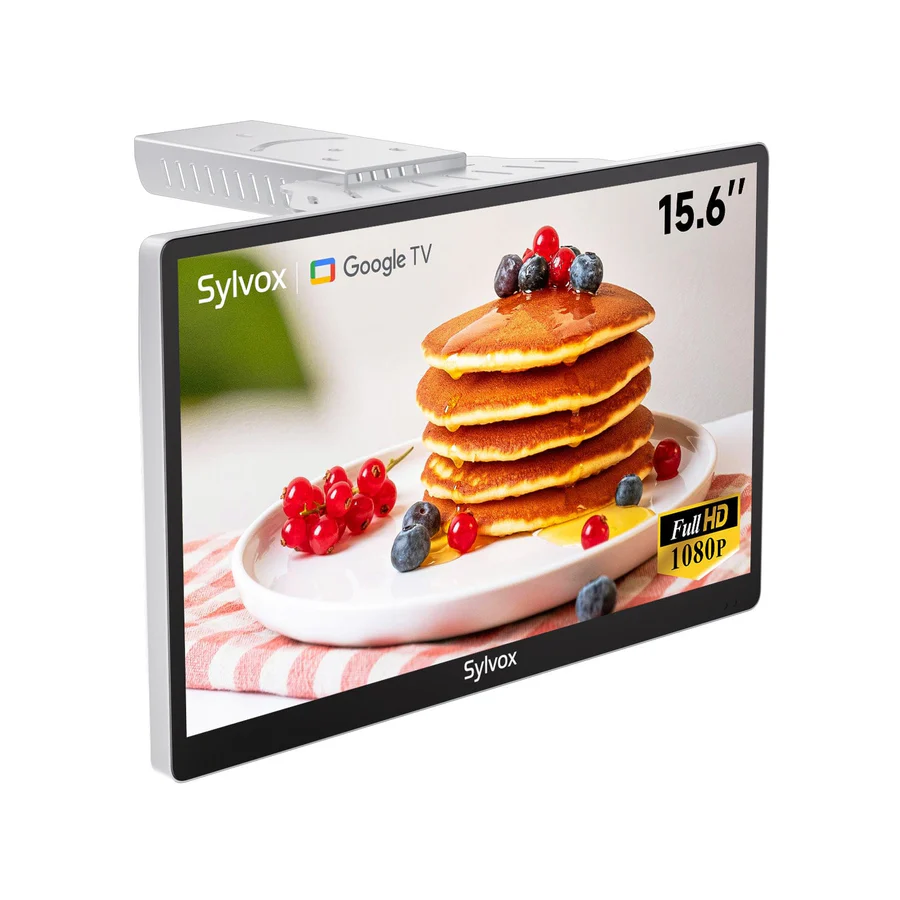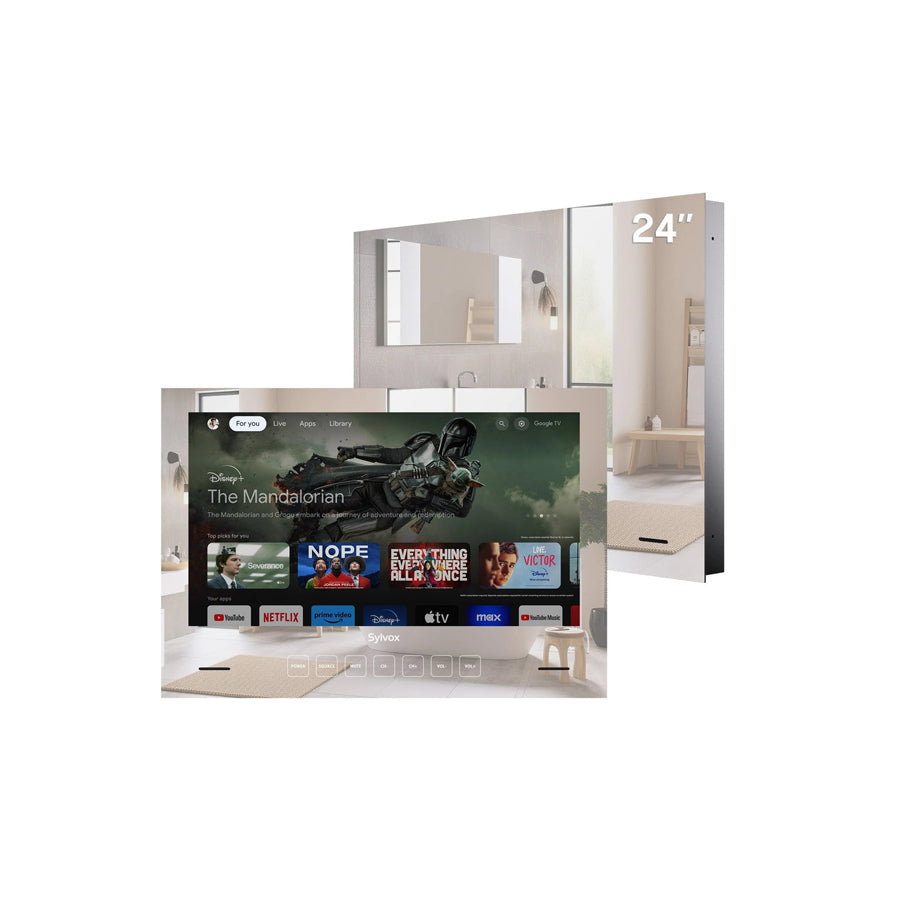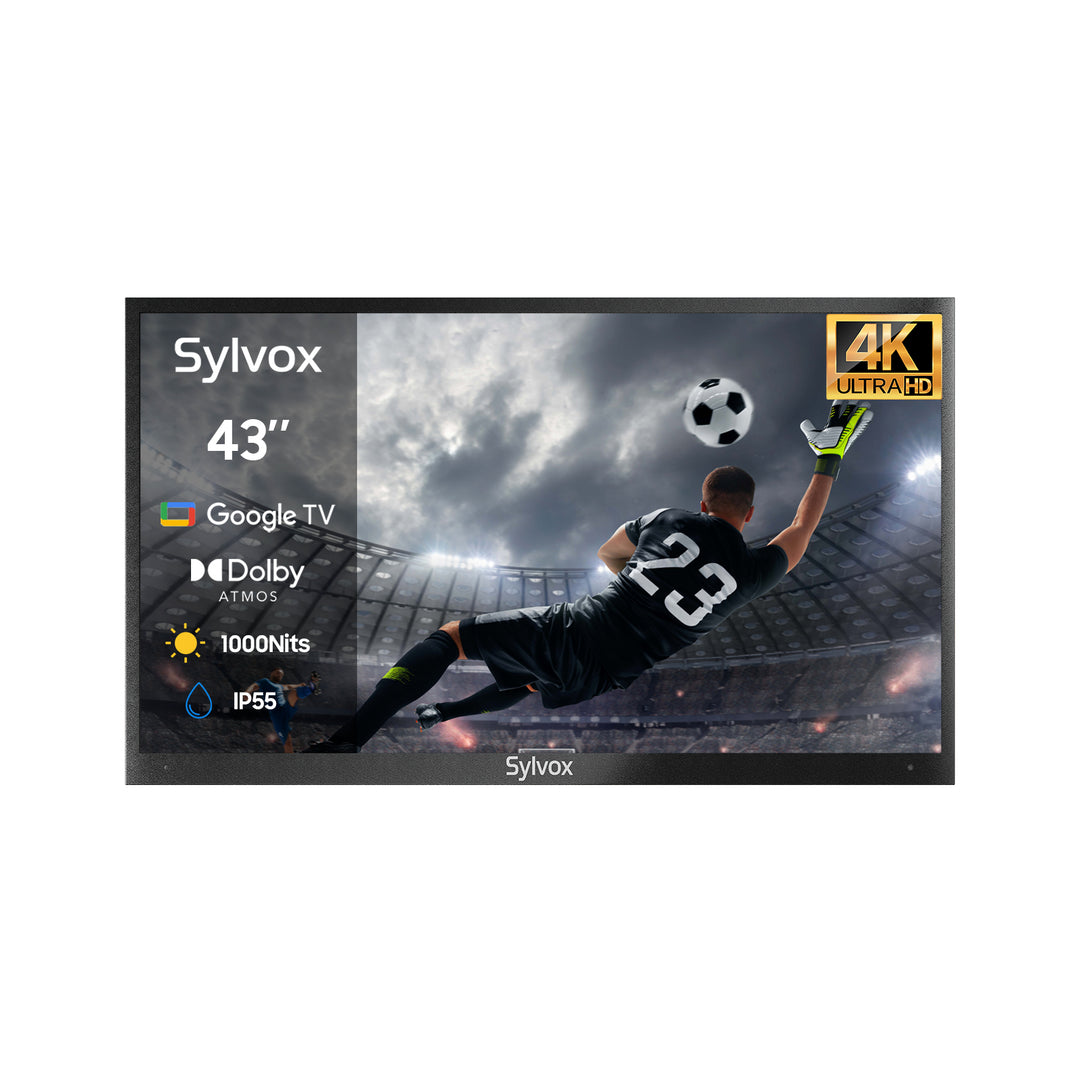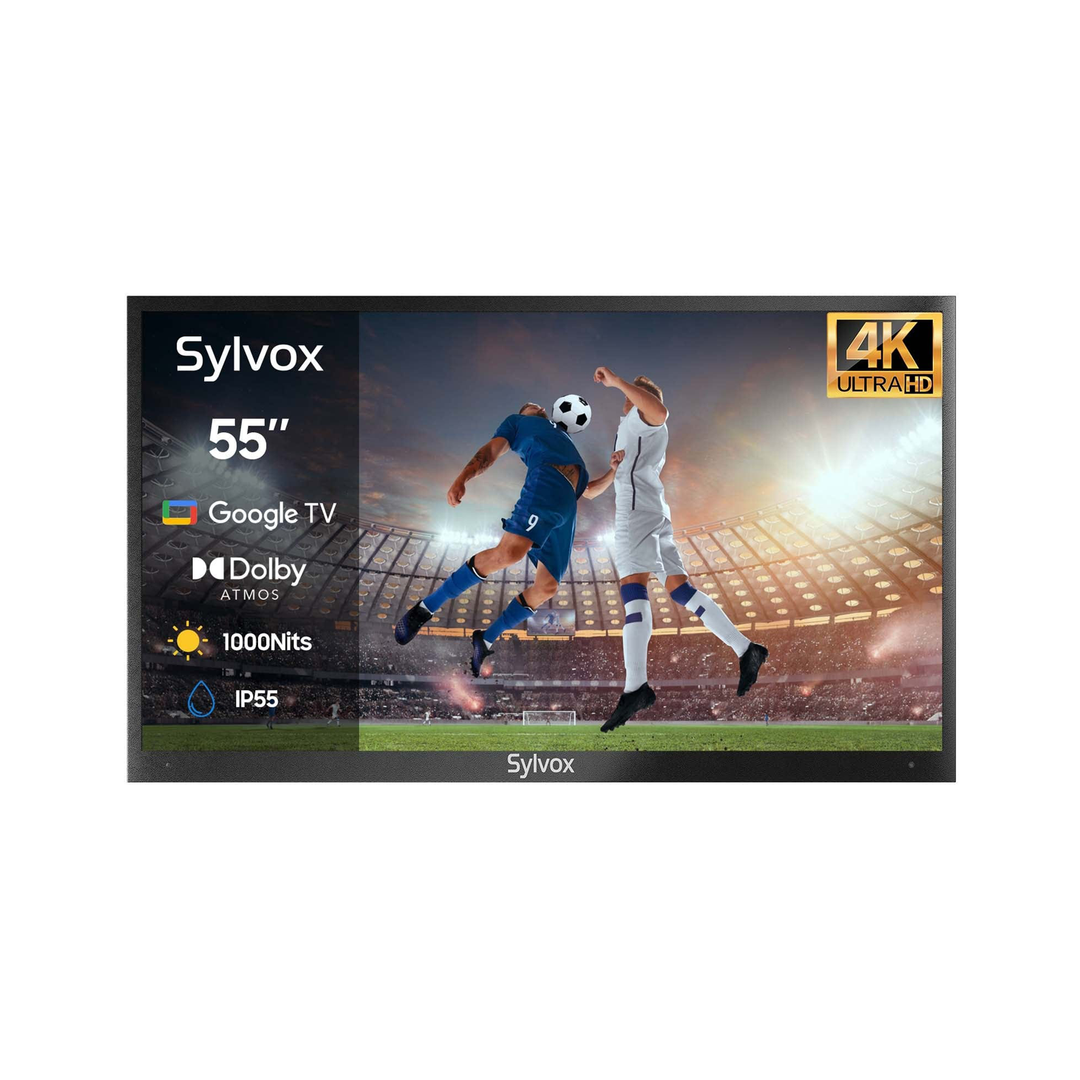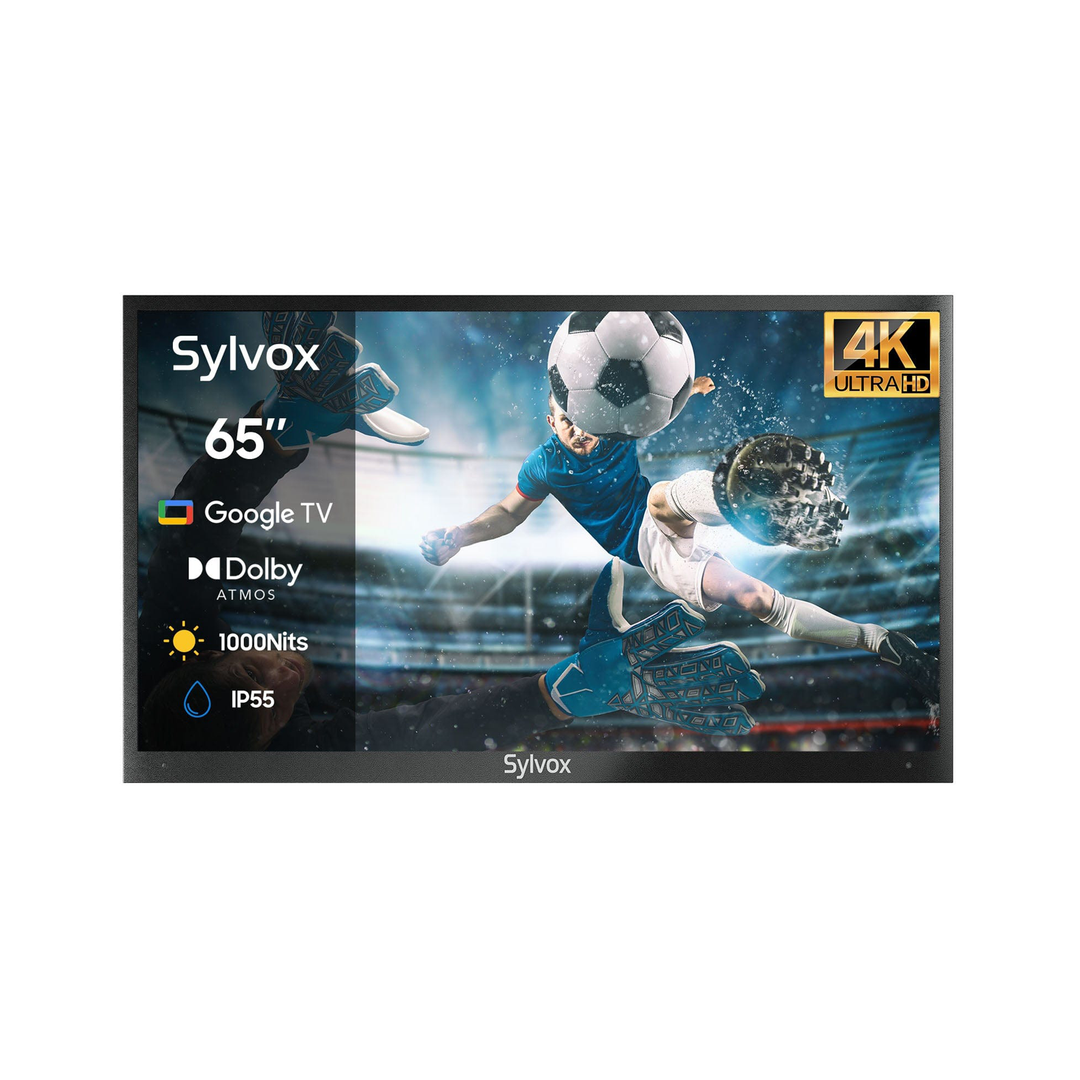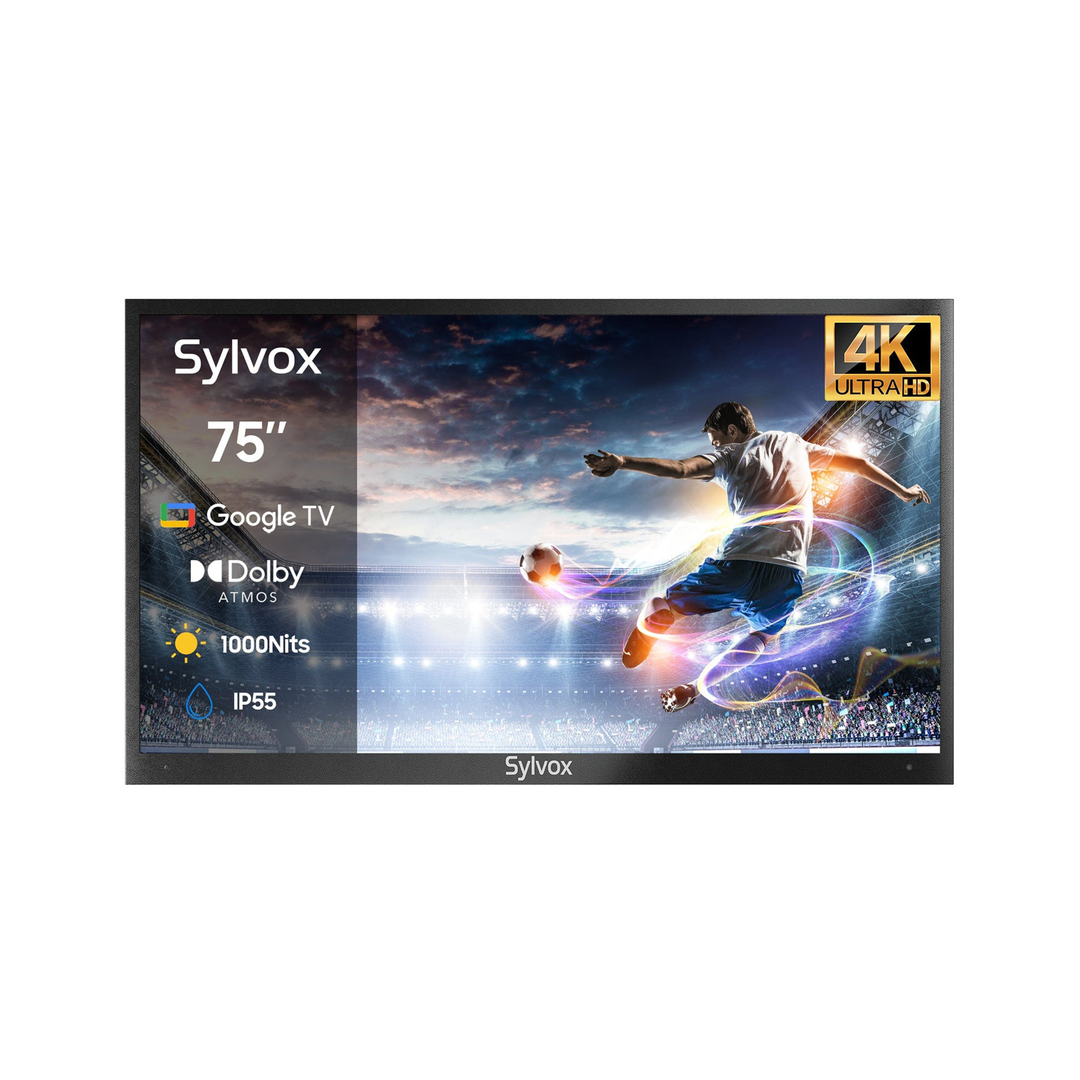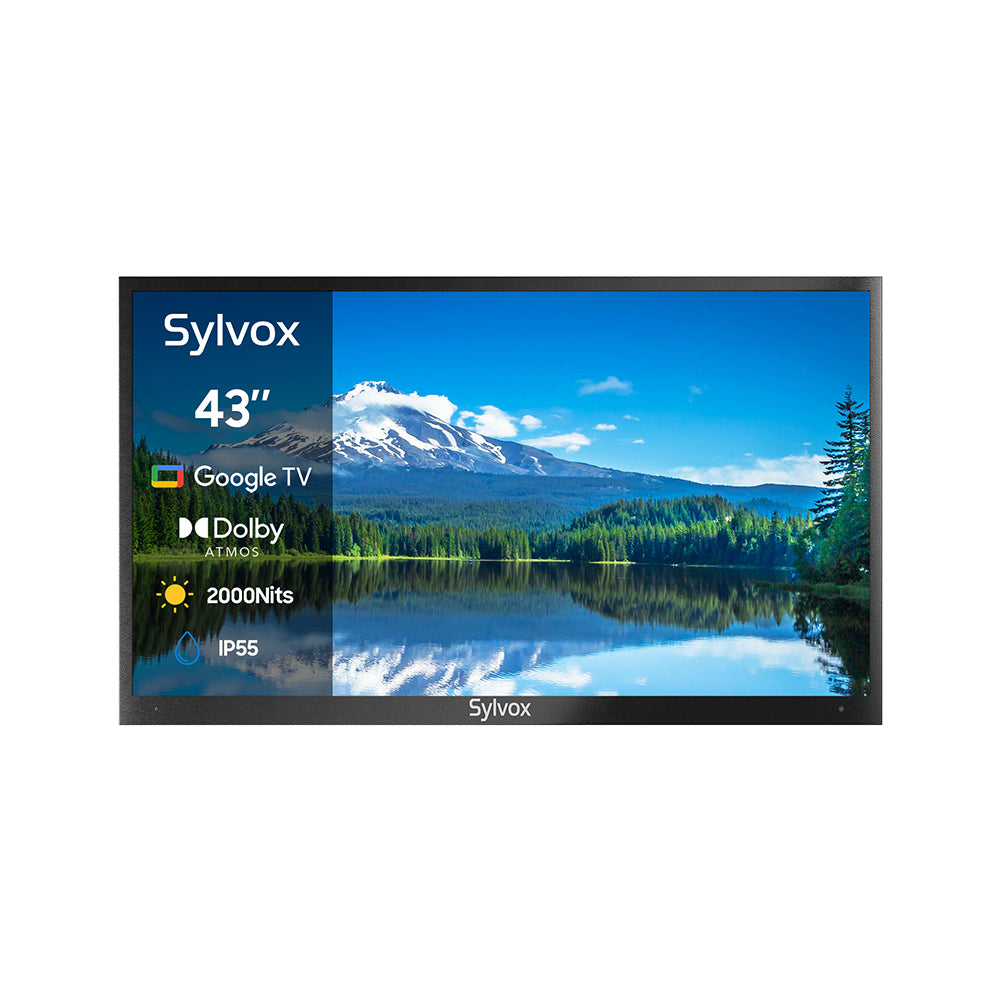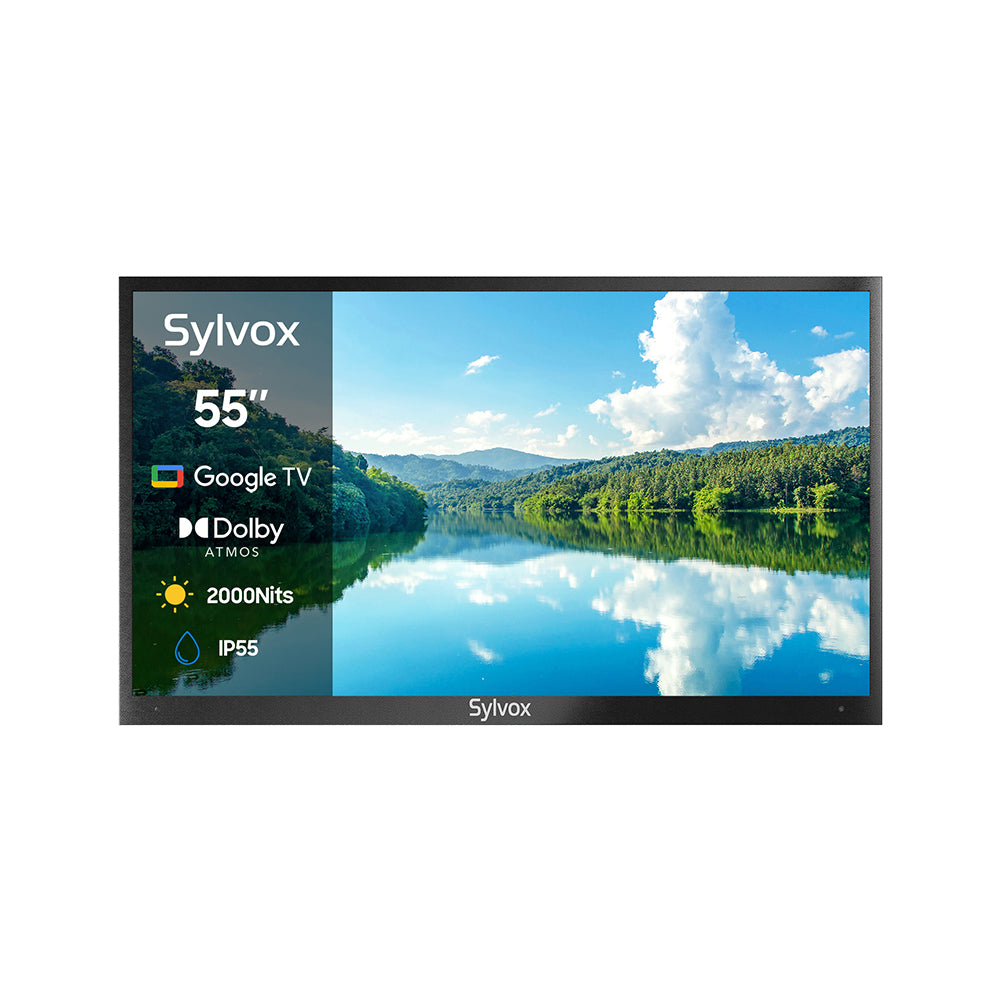
Sylvox
Aug 27, 2024
Higher Brightness, 100% Waterproof, Aluminum Housing, IP55 rating, Anti-glare Screen
How to choose and install Sylvox outdoor TV?
Table of Content
- Can I use an indoor TV outside?
- How Outdoor TVs Work?
- How to choose outdoor TV?
- Comparing Sylvox Outdoor TVs
- Best Outdoor TV in 2024
- Sylvox Outdoor TV Installation Guide
Still worried about your TV being exposed outdoors? Or frustrated when you can't see the screen clearly while your family and friends are gathered around? Choose Sylvox—our outdoor TVs are designed specifically for such scenarios, offering you a unique and enjoyable viewing experience.
Can I use an indoor TV outside?
Absolutely not. It might seem like there's no major issue with placing an indoor TV outdoors, but trust me, you'll regret it. Even on a covered patio or in a sheltered garden, indoor TVs are not suitable. They can't withstand the elements over time, and your viewing experience will be far from ideal.
Here’s why:
①Weather Impact: Condensation can form on the TV screen, and wind can blow water or dust into the TV's interior. Prolonged exposure to such conditions accelerates corrosion and damage.
②Safety Hazards: A damp environment not only harms the TV but also increases the risk of electrical shocks outdoors.
③Extreme Temperature Damage: Standard TVs are prone to damage in extreme temperatures. They can overheat in high temperatures, even if placed in the shade, and lack effective insulation to prevent freezing damage in cold winters.
④Insufficient Brightness: Standard TVs don't have the brightness needed to cope with strong outdoor light. Even high-definition indoor TVs will suffer significantly in viewing quality when used outside.
⑤Warranty Issues: Using an indoor TV outdoors often leads to frequent malfunctions. If the TV fails multiple times, you might not be able to obtain warranty service from the manufacturer.
How Outdoor TVs Work?
You might be wondering why outdoor TVs can be exposed to the elements and still function properly, while indoor TVs cannot. Let’s delve into the design features that make outdoor TVs capable of withstanding outdoor conditions:
①Durable Exterior: Outdoor TVs are treated with sealing and powder coating to prevent rust and corrosion. This design ensures that moisture and dust cannot penetrate the internal components.
②Safety: The power cables of outdoor TVs are specially treated and certified for outdoor use, enhancing safety and reliability.
③Temperature Management: Outdoor TVs are equipped with built-in fans, heaters, and/or temperature dispersal systems to protect internal components from extreme heat and cold. This means you don’t have to worry about performance issues even in harsh weather conditions.
④Ultra-Bright Screens: While indoor TVs typically have brightness levels of 350-450 nits, outdoor TVs feature screens that can reach 1000-2000 nits. This high brightness ensures clear visibility even in direct sunlight.
⑤After-Sales Support: Designed specifically for outdoor use, these TVs come with warranties that cover their specialized features, so you can use them confidently without worrying about warranty issues.
In summary, the design and technology behind outdoor TVs ensure they can handle various environmental factors while providing an excellent viewing experience.
How to Choose an Outdoor TV?
When deciding to purchase one or more outdoor TVs, here are some key factors to consider:
1. Expected Use Environment
Partial Sunlight Outdoor TVs: These are ideal for shaded areas where direct sunlight is minimal, such as under a gazebo or on a covered deck. They offer good visibility in conditions with less direct sun exposure.
Full Sunlight Outdoor TVs: Designed for areas with direct and intense sunlight, these TVs ensure clear, vibrant viewing even in full sun. They are built to handle bright light conditions without compromising image quality.
2. IP Rating
Importance of IP Rating: When buying an outdoor TV, prioritize models with an IP rating, which indicates their dust and water resistance. For outdoor use, choose a TV with at least an IP65 rating, which signifies protection against dust and low-pressure water jets from any direction, ensuring worry-free outdoor installation.
Additional Protection: Even with weatherproof designs, consider adding protective covers or enclosures in areas prone to heavy rain or storms. Also, avoid prolonged exposure to extreme temperatures or direct sunlight, as these can impact performance and longevity.
3. Audio Quality
In a noisy outdoor environment, audio quality is crucial. Choose a TV with robust built-in speakers, or connect external speakers to enhance sound. Investing in a soundbar or outdoor speaker system can provide a fully immersive outdoor entertainment experience.
4. Size and Placement
Size Considerations: Think about the size of the TV relative to your outdoor space. Evaluate viewing distance, angles, and potential obstructions or reflections to optimize your viewing experience without disrupting the outdoor environment.
Common Sizes: Popular TV sizes for outdoor use include 43 inches, 55 inches, 65 inches, 75 inches, with larger options like 85 inches and 98 inches available. Choose a size that fits your space and meets your viewing needs.
By keeping these considerations in mind, you can select an outdoor TV that enhances your outdoor entertainment experience and stands up to environmental challenges.
Sylvox currently offers outdoor TV sizes of 43 inches, 55 inches, 65 inches, and 75 inches.
If you're unsure about which size to choose, refer to the table below for guidance:
| Viewing Distance | Recommend |
|---|---|
| <1m | 43" TV or smaller |
| 1.5m | 55" TV |
| 2m | 65" TV |
| 2.5m | 75" TV |
| >3m | 80" TV or larger |
If you're unsure about the viewing distance or TV size, you can use the following calculations:
1. If You Know the Estimated Viewing Distance but Are Unsure About TV Size:
To determine the appropriate TV size, multiply the viewing distance by 1.2. For example, for a TV with a 75-inch screen, this means a viewing distance of approximately 90 inches or 2.3 meters.
2. If You've Decided on a TV Size but Are Unsure About the Suitable Viewing Distance:
Divide the viewing distance by 1.2 to estimate the required TV screen size. For instance, if your viewing distance is 2.5 meters, a recommended TV screen size would be approximately 82 inches.
Comparing Sylvox Outdoor TVs
Expertly constructed outdoor TVs, 100% waterproof and 3-6X brighter than indoor options. Durable metal materials withstand all weather conditions for extended lifespan.
Sylvox Partial Sun Outdoor TVs
| Feature | Deck Pro | Deck Pro 2.0 | Deck Pro 2.0 QLED |
|---|---|---|---|
| Safe for outdoor use | ✔ | ✔ | ✔ |
| Weatherproof (rain, snow, moisture, dust) | ✔ | ✔ | ✔ |
| Operating temperature range | -30°C to 50°C | -30°C to 50°C | -30°C to 50°C |
| Water resistance level | IP55 | IP55 | IP55 |
| Resolution | 4K | 4K | 4K |
| Display technology | LCD | LCD | LCD |
| Backlight | DLED | DLED | QLED |
| Brightness level | 1000nit | 1000nit | 1000nit |
| Anti-reflective | ✔ | ✔ | ✔ |
| Anti UV | ✔ | ✔ | ✔ |
| Scratch-resistant | ✔ | ✔ | ✔ |
| Unique cooling technology | ✔ | ✔ | ✔ |
| System | Android | ||
| Commercial class | ✔ | ✔ | ✔ |
| Dolby Atmos | ✖ | ✔ | ✔ |
| Voice control((Google Assistant) ) | ✔ | ✔ | ✔ |
| Download app | ✔ | ✔ | ✔ |
| Screencast | Android IOS | Android IOS | Android IOS |
Sylvox Full Sun Outdoor TVs
| Feature | Pool Pro | Pool Pro 2.0 | Pool Pro 2.0 QLED |
|---|---|---|---|
| Safe for outdoor use | ✔ | ✔ | ✔ |
| Weatherproof (rain, snow, moisture, dust) | ✔ | ✔ | ✔ |
| Operating temperature range | -30°C to 50°C | -30°C to 50°C | -30°C to 50°C |
| Water resistance level | IP55 | IP55 | IP55 |
| Resolution | 4K | 4K | 4K |
| Display technology | LCD | LCD | LCD |
| Backlight | DLED | DLED | QLED |
| Brightness level | 2000nit | 2000nit | 2000nit |
| Anti-reflective | ✔ | ✔ | ✔ |
| Anti UV | ✔ | ✔ | ✔ |
| Scratch-resistant | ✔ | ✔ | ✔ |
| Unique cooling technology | ✔ | ✔ | ✔ |
| System | Android | ||
| Commercial class | ✔ | ✔ | ✔ |
| Dolby Atmos | ✖ | ✔ | ✔ |
| Voice control((Google Assistant) ) | ✔ | ✔ | ✔ |
| Download app | ✔ | ✔ | ✔ |
| Screencast | Android IOS | Android IOS | Android IOS |
To compare Sylvox's outdoor TVs and find the one that best fits your needs, please refer to the detailed comparison page. On this page, you can view specifications, features, and sizes for Sylvox’s outdoor TVs, helping you make an informed decision based on your specific requirements.
Top 5 Bright TVs For Backyard & Balconies
Sylvox Outdoor TV Installation Guide
Still unsure about installing your Sylvox outdoor TV after purchase?
Don’t worry—here’s a breakdown of the available installation options for Sylvox outdoor TVs, along with the weight and dimensions for each TV size.
Weight & Dimensions:
43": 38.41x3.44x22.64 / 37.0 lbs
55": 48.98x3.44x28.59 / 54.5 lbs
65": 57.61x3.44x34.80 / 66.2 lbs
75": 66.32x3.44x38.35 / 89.3 lbs
VESA Standards:
43":400×200mm
55"/65"/75":600×400mm
Below is a detailed introduction and considerations for each Sylvox Outdoor TV installation method:
1. Wall Mounting
This is the most common method, suitable for installing the TV on exterior walls of the house, garden walls, or dedicated TV walls. Wall mounting saves space and allows you to adjust the bracket angle for optimal viewing.
Recommended Accessories:
Sylvox Wall Mount
Other compatible wall mounts
Advantages:
Saves floor space
Neat and tidy
Adjustable bracket for flexible viewing angles
Considerations:
Ensure the wall is sturdy enough to support the TV
When choosing a mount, ensure it matches the VESA standard and can support the weight of the Sylvox outdoor TV
2. Stand Installation
Using a dedicated outdoor TV stand, you can place the TV on the ground in the yard or on the patio. Stands are usually mobile and can be repositioned as needed.
Advantages:
Easy to move, highly flexible
Does not require wall support
Considerations:
Ensure the stand is stable
Choose a stand made of weather-resistant materials
3. Ceiling Mounting
If the outdoor area has a canopy or ceiling, the TV can be mounted on the ceiling. This method is suitable for patios, gazebos, or any area with overhead structures.
Sylvox Ceiling Mount Plate: 200×208mm
Other Brands: Ensure they meet the VESA standard and weight requirements for Sylvox outdoor TVs
Advantages:
Saves floor and wall space
Suitable for specific structural environments
Considerations:
Ensure the ceiling structure is sturdy enough
Properly design the installation height and angle
4. Motorized Lift Installation
Using a motorized lift system, the TV can be hidden in the ground, cabinet, or other structures and raised when needed. This installation method is technologically advanced and ideal for users seeking a high-end experience.
Advantages:
High-end and stylish
Protects the TV and saves space
Considerations:
Higher installation cost
Requires regular maintenance of the motorized system
5. External Waterproof Bluetooth Speakers
Advantages:
IP65 Waterproof Sound Bar
2.0 Channel
Digital Signal Processor with 4 EQ settings
Bluetooth
HDMI ARC and CEC
Wall mountable
Dimension (inch):38.38 x 3.62 x 2.44 (L/W/H)
Net Weight (lb): 9LB
Get started today! Don’t hesitate—purchase our outdoor TV now and enjoy a 5% discount on your first order.
If you have any questions regarding installation, please feel free to contact us at presale.uk@sylvoxtv.com.
Have Any Questions?
We are here to answer all of your queries

